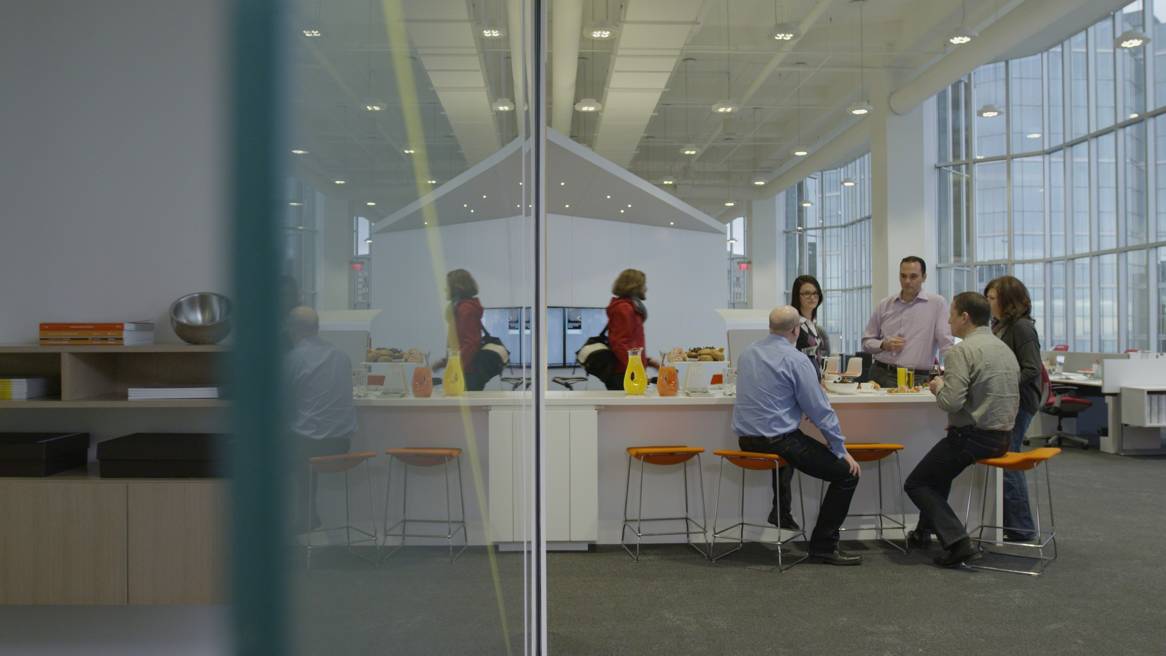Six Dimensions of Wellbeing in the Workplace
Wellbeing is a competitive advantage in today’s business world.
The Steelcase team’s research synthesis identified six dimensions of wellbeing that can be impacted by the design of the physical environment. The foundational concept that links all six dimensions is what Steelcase refers to as an “interconnected workplace,” and which offers employees choice and control over where and how they work.
“To foster wellbeing, employees need to have a variety of work settings that they can choose from,” notes de Benoist. “Traditionally workplaces have been designed for efficiency, and sometimes take a ‘one-size-fits-all’ approach. But that doesn’t offer employees the ability to choose the right kind of setting for the work they need to do. When they have choices, employees have a sense of control that helps them feel more empowered, engaged and less stressed.”
Three key ways to offering this level of choice and control are:
Palette of Place
An ecosystem of interrelated zones and settings that provide users with a range of spaces that support their various modes of work.
Palette of Posture
A range of solutions that encourage people to sit, stand and move while supporting the multiple technologies they use.
Palette of Presence
A range of mixed-presence experiences (physical and virtual) in workplace destinations designed to augment human interaction.
Combined in workplace design, these principles lay the groundwork for addressing the six key dimensions of worker wellbeing identified by Steelcase researchers.
- Optimism: Fostering creativity and innovation
- Mindfulness: Fully engaged
- Authenticity: Really yourself
- Belonging: Connecting to others
- Meaning: A Sense of purpose
- Vitality: Get-up-and-go
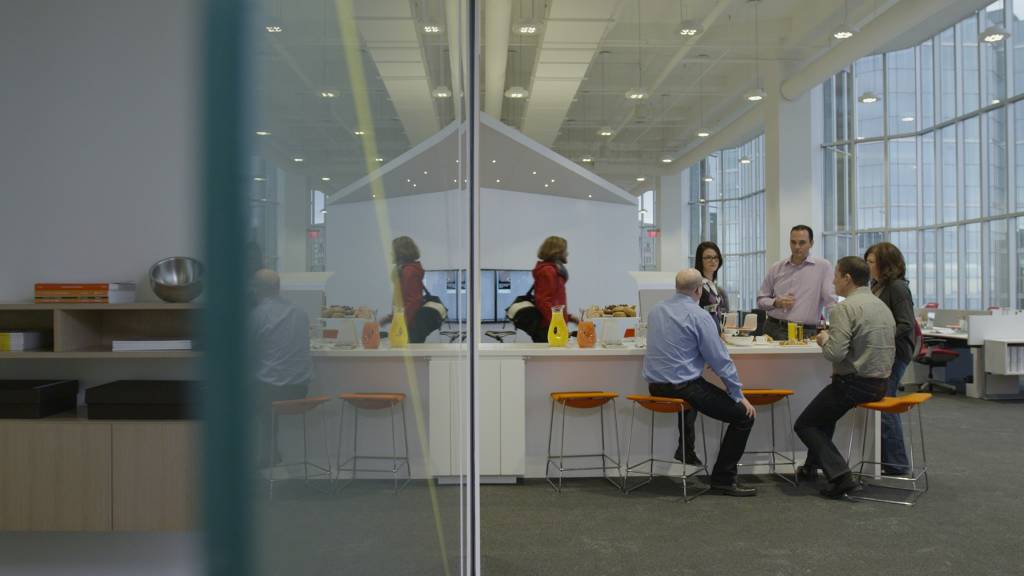
1. Optimism – FOSTERING CREATIVITY AND INNOVATION
Optimism is more than just expecting positive outcomes in various domains of life. It is about being on a quest for discovery, eager to try new approaches versus being overly risk adverse. It means interpreting and remembering events in a positive light, as well as creating enjoyment in the present and seeing possibilities for the future.
Researchers at the University of California recently found that part of our optimism, self-esteem and sense of mastery (the ability to affect a positive change in life) is genetic. But, they also noted that genes are not destiny and that activities, relationships and environment can have almost as much impact in the equation. Emotions can play a significant role in our tendencies toward optimism. Fear breeds pessimism.
Optimism is critical to the type of work that organizations need today: creativity and innovation. It influences a wide range of behaviors such as seeing the big picture, exploring ideas, being open to others, taking more risks and facing difficult tasks. It also makes people open to change. Understood in this way, optimism has important implications for an organization’s agility and resiliency. Because of this, optimistic employees tend be more productive employees in today’s economy.
“Optimism may be the most important job skill in the 21st century,” notes de Benoist. “Organizations are faced with so much volatility and stress that the people who can rise above fears and anxiety are the ones who can help build a culture that is better able to thrive in our world.”
Cultivating optimism in the workplace
Empowering workplaces support continuous experimentation and show the legacy of the brand and organization in positive ways to reinforce progress and possibility. “Workers need to feel a sense of individual influence and control over their environment, versus feeling quashed by standardization and rigidity,” advises de Benoist.
Design Considerations:
- Allow choice and control over where and how people work.
- Create spaces that allow personalization and individual customization, instead of tightly enforced workplace standards.
- Offer settings and affordances that help employees feel supported in their work.
- Design for transparency, so people can see and be seen, and build trust.
- For application ideas designed to support physical, cognitive and emotional wellbeing in the workplace see the Wellbeing Thoughtstarters.

2. Mindfulness – FULLY ENGAGED
Mindfulness means balancing the intense pace of life with being fully present in the moment. Today technology presents many opportunities for multitasking, which allows people to be physically present in a meeting, for example, but mentally lost in email.
The focus on mindfulness in business has grown exponentially as organizations recognize that rapid changes in technology, the marketplace and the global playing field have caused volatility, uncertainty, chaos and ambiguity. These realities create stressful conditions for people in organizations and call for a new style of leadership.
Mihaly Czsikzsentmihalyi, noted psychologist and author of the seminal book “Flow,” relates the notion of flow with his study of happiness and creativity. It’s the antithesis to multitasking and a direct result of mindfulness—i.e., being fully immersed in a feeling of energized focus, full involvement and enjoyment in what you’re doing.
“Mindfulness is a fusion of the mind and body when you lose the notion of time,” says de Benoist. “And it’s not just something you can achieve alone. People can work together in mindfulness, too, performing like a jazz group, all mindful in the moment of now.”
Cultivating mindfulness in the workplace
“Workers need physical spaces that help them manage the cognitive overload of their daily lives and be fully present in the moment,” notes de Benoist.
Design Considerations:
- Create spaces that help people connect with others one-on-one and eye-to-eye, and not just through their technology devices.
- Design areas that allow workers to control their sensory stimulation and choose if they want to amp it up or down.
- Offer places that are calming, through the materials, textures, colors, lighting and views.
- Create areas where people can connect with others without distractions or interference
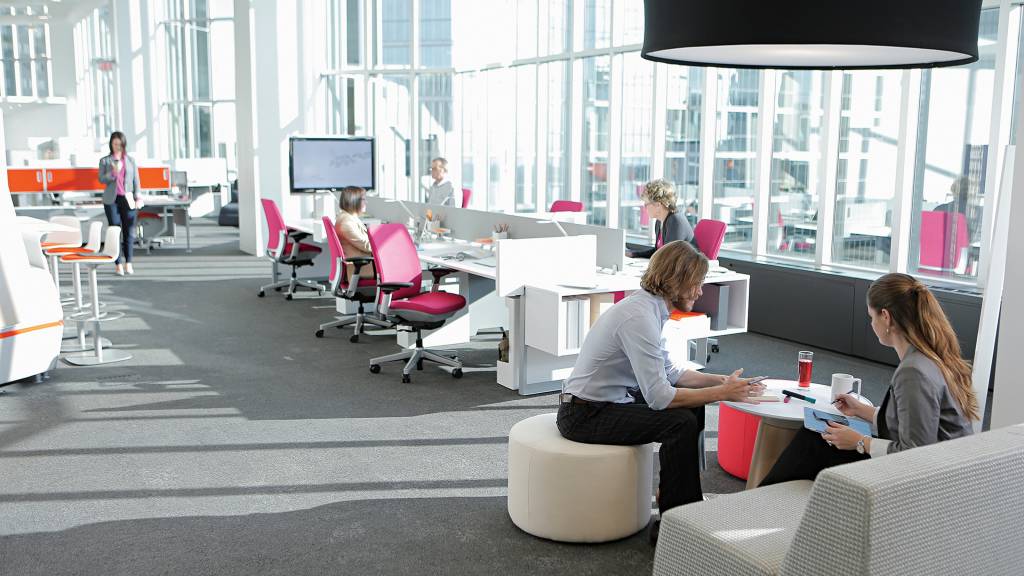
3. Authenticity – REALLY YOURSELF
In workplaces of the past as popularized by Dilbertville and “Mad Men,” allowing yourself to be vulnerable or show emotion at work was considered unacceptable. With “fight or flight” emotions in high gear, many workers are still accustomed to defending themselves by keeping up a pretense of perfection and expected behaviors, which leads to frustration, resentment and unhealthy behaviors.
Wellbeing, in contrast, is cultivated by personal expressiveness — the freedom to be who you are, at work as well as away from work.
Gallup poll data from more than a decade of surveying people has revealed that the most important factor in wellbeing on the job is to have a best friend at work. Relationships anchor people’s commitment to the larger organization. Having close friends and positive interactions can’t happen without trust, which requires authenticity. “Even in Eastern cultures with their legacy of collectiveness versus individualism, the authenticity of self and being able to express that at work is become more important to wellbeing,” says Arantes.
Cultivating authenticity in the workplace
“Workers need spaces where they can feel a part of the organization’s culture, while feeling encouraged to express their own ideas and values,” notes Arantes. “Leaders set standards and a tone of authenticity, while customizable work environments and social settings can reinforce the message.”
Design Considerations:
- Create spaces that help people feel comfortable to express themselves and share their ideas.
- Incorporate informal, non-constricting environments with a home-like feel.
- Design areas that help people connect their personal values to the brand values.
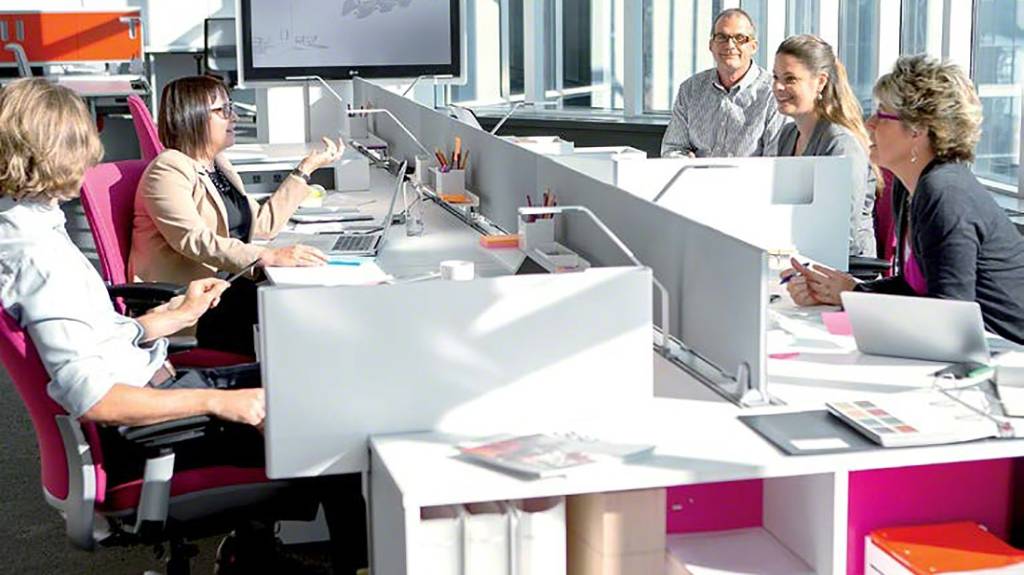
4. Belonging – CONNECTED TO OTHERS
A meaningful life means feeling connected to other people. Social connections at work are sustaining, and feeling useful to others is a powerful way to generate positive emotions.
Psychologist Abraham Maslow positioned belonging at the third level of his famous hierarchy of universal human needs, preempted only by basic physiological needs (food, water, sleep, etc.) and safety/security needs. Numerous studies and experiments have led to the belief that humans are genetically wired to need one another, and Gallup data provides empirical evidence that having close friends and positive interactions at work significantly increases engagement with the organization.
Relationships anchor people’s commitment to an organization, its brand and its purpose. Without meaningful connections to people, organizations can seem anonymous. Because of this, mobility, alternative work strategies and telepresence across geographies must be intentionally crafted so that employees don’t lose their sense of belonging.
“Mobility can be positive because you’re giving people flexibility, and videoconferencing is fast becoming a fact of everyday work, especially for global teams. But it’s important to ensure that people have meaningful connections to others and understand that, wherever they are, they are valued in the organization. Employees need to know they are integral participants in something larger than themselves and others in the organization care about them, ” says Arantes.
Cultivating belonging in the workplace
“As work becomes increasingly mobile and global, creating a sense of belonging is a bigger challenge than ever, but certainly not less important,” says Arantes. “Leading organizations make sure their workplaces provide reasons for people to choose to work there by making it easy to collaborate with co-workers and connect to technologies. They put effort into creating an equal sense of community and belonging for mobile and distributed employees, as well as those physically present.”
Design Considerations:
- Create entrances that are welcoming with visible hosting for people who don’t work there routinely.
- Provide ample and well-equipped spaces for mobile and resident workers to work individually or in teams.
- Offer videoconferencing configurations that allow remote participants to see content in the room and on the walls, and to hear everyone equally.
- Design informal areas for socialization, in person as well as virtually
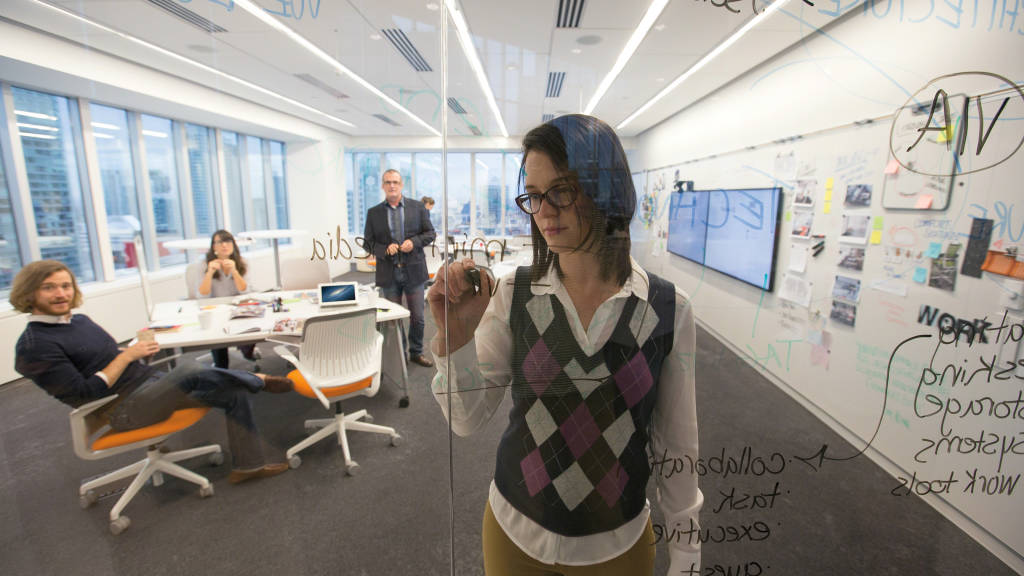
5. Meaning – A SENSE OF PURPOSE
People need to use their strengths, understand their impact and see how they contribute to organizational goals. Edward Diener, nicknamed “Dr. Happiness” and a senior scientist for the Gallup Organization, distinguished that the so-called “calling orientation,” in which people are passionate about what they do, is intrinsically the most rewarding.
A sense of purpose helps build a resilient enterprise based on trust and collaboration. It infuses “yes power” throughout an organization, says de Benoist.
“Beliefs are the rituals of the everyday that a community shares,” he notes. “In the best cases, a person’s sense of meaning in life and the purpose of the company are compatible and augment each other. When people around us believe the same things as we do and work toward similar things in the same space, it creates a sense of harmony in context.”
“Brand isn’t just for the client,” says Arantes. “The brand is also for the people inside the company to have a meaningful understanding of what the brand stands for and be mindful of it in their everyday work.
“Without shared understanding of what you want to accomplish, it’s hard to get people aligned on what their goals are and how to get there. People need meaning in order to know that their work is not going to waste. It’s possible for even a large body of people to move quickly if they’re aligned on the same goal and meaning.”
Cultivating meaning in the workplace
“How we spend our time, doing the right things in the right way, can powerfully impact wellbeing,” says de Benoist. “Spaces that are intentionally designed to help people accomplish meaningful goals can make a tremendous difference in individual performance and overall organizational results.”
Design Considerations:
- Include spaces beyond the lobby that reinforce the brand, purpose, history and culture of the company.
- Leverage vertical real estate to make thinking and progress visible.
- Use technology to display real-time information.
- Create an ecosystem of spaces that give people choices and empower them to work productively alone or together.
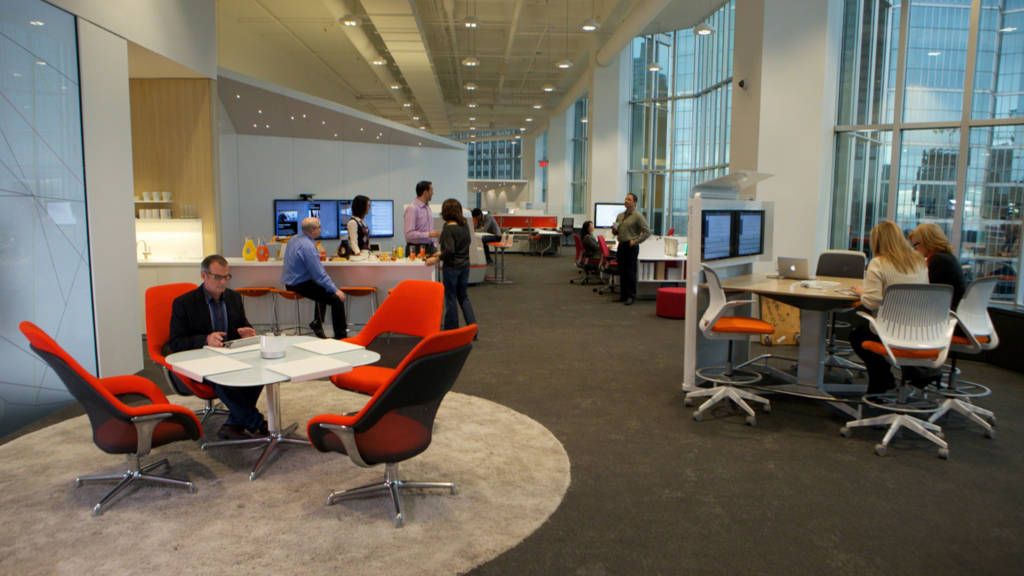
6. Vitality – GET UP AND GO
Scientists continue to make breakthrough discoveries about how the mind and body function as an interrelated system. Brain chemistry expert Dr. Candace Pert, a neuroscientist at the U.S. National Institute of Health, wrote in her 1997 book, “Molecules of Emotion,” that receptors and peptides run every system in the human body, creating what she termed a “bodymind’s intelligence.”
Continuing to explore the science of vitality, recent medical studies published in respected journals such as the European Association for the Study of Diabetes and mass media such as The New York Times, have raised awareness of the negative effects of prolonged sitting. Dr. James A. Levine of the Mayo Clinic, a leading researcher in the field of inactivity studies, has noted an explosion of research in this area “because the health care cost implications are so enormous.”
The risks are mental as well as physical, since muscle inactivity produces a series of harmful metabolic effects including a slowdown of the flow of nutrients to the brain, affecting alertness.
Clearly, engaging the body in movement is essential for supporting physical and mental vigor at work. Movement is the body language of ideas,” says de Benoist. “Taking different postures stimulates the mind, and healthy environments encourage people to move, eat well and exercise as healthy practices.”
In addition, sensory experiences in work environments are important, too. Using our senses and nervous system, we interact constantly within the context of spatial environments, processing touch, light and sound and other stimuli that influence mental and physical states. Because stimuli have direct and often immediately perceptible positive or negative consequences, as humans we naturally want choice and control of our environments, seeking out the places that “feel good” to us.
“When you get to the workplace, you need the tools and environments that are going to support you, whether it’s to work alone or have a collaborative session or eat a meal in a pleasant place or go outdoors,” says Arantes. “Providing a palette of place that supports frequent movement is fundamental for sustaining vitality.”
Cultivating vitality in the workplace
How we experience a place affects our actions. Investments in the workplace can completely change employees’ attitudes and behaviors, creating a new spatial vibe that boosts people’s motivation and performance within a relatively short time.
Design Considerations:
- Design areas that give people choices for controlling the level of sensory stimulation around them.
- Provide easily adjustable furniture to fit a range of sizes, needs and preferences and to promote movement throughout the day.
- Include cafés with healthy food choices and displays.
- Bring nature in with daylight, views, ventilation, patios, etc.
- Support active, healthy lifestyles with centrally located stairways, outdoor walking paths, bicycle racks, etc.
Amplifying people’s performance
IBM’s CEO Study notes that the move toward a more collaborative, communicative, creative, flexible, and ultimately more innovative organization is not something they are delegating to HR. They see the challenge as so critical to their business performance that they plan to engage the entire C-suite and personally lead this shift.
To impact this goal, leaders at all levels of the organization will gain greater traction if they incorporate a focus on wellbeing into their strategy. Employers make a significant investment in people and expect a positive ROI over time. For those who understand that their employees’ wellbeing is imperative for bottom line success, the potential return is high. Conversely, it’s shortsighted and risky to shortchange people’s potential with inadequate, unsupportive or uninspiring work environments that undermine their wellbeing.
“Businesses understand that they need people more than ever to get innovative work out the door. It’s really about getting people to blossom,” says Arantes. “In the past leaders may not have recognized the impact employee wellbeing could make. That’s changing, there’s a different mindset.”
Wellbeing is a competitive advantage in today’s business world. To achieve it, workers need mental and physical health, nurtured by a supportive environment that gives them the emotional capacity to interpret and experience events in a way that leads to productive, positive actions. The best places help people engage deeply in what they do by giving them what they need for wellbeing at work.
The results can be self-perpetuating: a systemic sense of wellbeing that easily becomes positively contagious, amplifying the performance of individuals, teams and the entire enterprise.
Next: Wellbeing Thought Starters
Introducing New Research on Engagement + the Global Workplace
1/3 of workers in 17 of the world’s most important economies is disengaged, according to new research from Steelcase. Working with global research firm Ipos, the Steelcase Global Report is the first to explore the relationship between engagement and the workplace.

